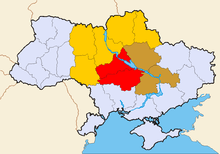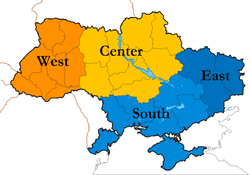Central Ukraine
Central Ukraine (Ukrainian: Центральна Україна, Tsentralna Ukrayina) consists of historic regions of left-bank Ukraine and right-bank Ukraine that reference to the Dnieper river. It is situated away from the Black Sea Littoral North and a midstream of Dnieper river and its basin.

Territory
The territory is often associated with the 17th century Cossack Hetmanate.
It mostly corresponds to:
- Generally, the territories in the Center of Ukraine, Poltava
- Kiev, the northern Ukraine, Polissia
- portions of the northeastern Ukraine, Severia, Little Russia
- Near western and southwestern Ukraine, eastern Podillia
Sometimes, a separate region of northern Ukraine is identified based on Severia and eastern Polissya, while Kirovohrad region is associated with the southern Ukraine and Black Sea Littoral.
Unlike the big cities of the Ukrainian south and east, the cities of the central Ukraine are among the oldest in Ukraine, among which are: Kiev, Vinnytsia, Poltava, Chernihiv. Also in contrast to the southeastern portion of the country, the region is more agricultural with extensive grain and sunflower fields in the heart of Ukraine.
Surzhyk, a term for mixed Russian-Ukrainian dialects, is commonly spoken throughout Central Ukraine, though, according to RATING and Research & Branding Group, most of the people self-identify as Ukrainian speakers.[1][2] In the major cities of Central Ukraine, Russian is the primary spoken language.
The average views of the regions inhabitants on sensitive issues in current Ukraine such as the Russian language, Joseph Stalin and Ukrainian nationalism tends not to be so extreme as in Western Ukraine, Eastern Ukraine and Southern Ukraine.[1][3][4][5]

In a poll conducted by Kyiv International Institute of Sociology in the first half of February 2014, only 5.4% of polled in Central Ukraine believed "Ukraine and Russia must unite into a single state", whereas nationwide this percentage was 12.5.[6]
Elections in the Central Ukrainian oblasts (provinces) have historically been competitive between pro-Russian and pro-Western candidates. However, since the 2004 Orange Revolution, Central Ukrainian voters have started to lean toward more pro-Western parties (Our Ukraine, Batkivshchyna)[7] and presidential candidates (Viktor Yuschenko and Yulia Tymoshenko).[8][9][10]
Oblasts (Administrative provinces)
| Oblast | Area in km2 | Population (Census 2001) | Population (1 Jan. 2012) | Notes |
|---|---|---|---|---|
| Cherkasy Oblast | 20,916 | 1,402,969 | 1,277,303 | |
| Chernihiv Oblast | 31,903 | 1,245,260 | 1,088,509 | |
| Kiev Oblast (excluding Kiev city) | 28,121 | 1,827,894 | 1,719,558 | |
| Kiev City | 836 | 2,611,327 | 2,814,258 | |
| Kirovohrad Oblast | 24,588 | 1,133,052 | 1,002,420 | |
| Poltava Oblast | 28,750 | 1,630,092 | 1,477,195 | |
| Sumy Oblast | 23,832 | 1,299,746 | 1,152,333 | |
| Vinnytsia Oblast | 26,492 | 1,772,371 | 1,634,187 | |
| Zhytomyr Oblast | 29,827 | 1,389,466 | 1,273,199 | |
| Total | 215,265 | 14,312,177 | 13,438,962 |
Note that sometimes Khmelnytskyi Oblast is considered a part of the Central Ukraine as it is mostly lies within the western Podillya.
Religion
According to a 2016 survey of religion in Ukraine held by the Razumkov Center, approximately 73.5% of the population of central Ukraine declared to be believers, while 4.8% declared to be non-believers, and 2.6% declared to be atheist.[11] Of the total population, 86.5% were Christians (76.7% Eastern Orthodox, 6.5% simply Christians, 1.9% Latin Rite Catholics, 1.0% members of various Protestant churches, and 0.4% members of the Ukrainian Greek Catholic Church), 0.3% were Jewish, and 0.1% were Muslims. Not religious and other believers not identifying with any of the listed major religious institutions constituted about 12.8% of the population.[11]
References
- The language question, the results of recent research in 2012, RATING (25 May 2012)
- Poll: Ukrainian language prevails at home Archived 2013-07-28 at the Wayback Machine, Ukrinform (7 September 2011)
- "Poll: Over half of Ukrainians against granting official status to Russian language - Dec. 27, 2012". Kyivpost.com. 27 December 2012. Retrieved 26 July 2018.
- (in Ukrainian) Ставлення населення України до постаті Йосипа Сталіна Attitude population Ukraine to the figure of Joseph Stalin, Kyiv International Institute of Sociology (1 March 2013)
- Who’s Afraid of Ukrainian History? by Timothy D. Snyder, The New York Review of Books (21 September 2010)
- How relations between Ukraine and Russia should look like? Public opinion polls’ results, Kyiv International Institute of Sociology (4 March 2014)
- Центральна виборча комісія України - WWW відображення ІАС "Вибори народних депутатів України 2012" Archived 2012-10-16 at the Wayback Machine
CEC substitues Tymoshenko, Lutsenko in voting papers Archived 2014-08-13 at the Wayback Machine - Communist and Post-Communist Parties in Europe by Uwe Backes and Patrick Moreau, Vandenhoeck & Ruprecht, 2008, ISBN 978-3-525-36912-8 (page 396)
- Ukraine right-wing politics: is the genie out of the bottle?, openDemocracy.net (January 3, 2011)
- Eight Reasons Why Ukraine’s Party of Regions Will Win the 2012 Elections by Taras Kuzio, The Jamestown Foundation (17 October 2012)
UKRAINE: Yushchenko needs Tymoshenko as ally again Archived 2013-05-15 at the Wayback Machine by Taras Kuzio, Oxford Analytica (5 October 2007) - РЕЛІГІЯ, ЦЕРКВА, СУСПІЛЬСТВО І ДЕРЖАВА: ДВА РОКИ ПІСЛЯ МАЙДАНУ (Religion, Church, Society and State: Two Years after Maidan), 2016 report by Razumkov Center in collaboration with the All-Ukrainian Council of Churches. pp. 27-29.
External links
